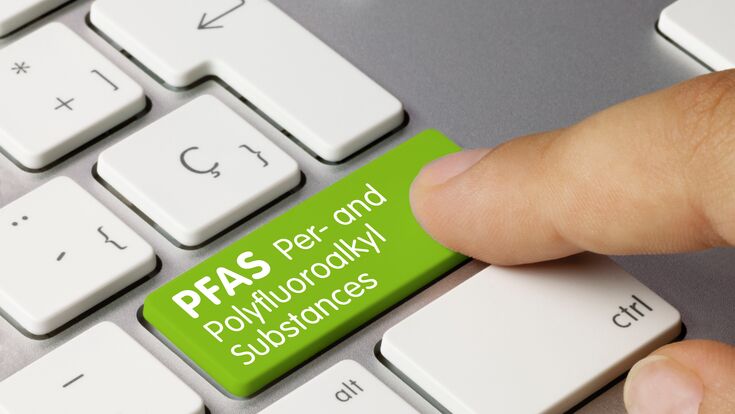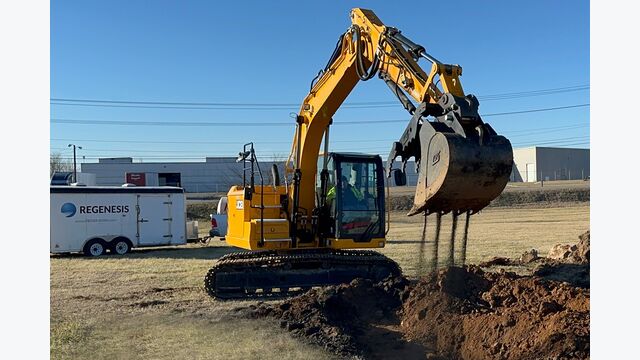Forever chemicals : "PFAS contamination presents both opportunities and challenges for the waste management industry"

Per- and polyfluoroalkyl substances - that's quite a mouthful. And although the acronym PFAS is commonly used, it doesn't change the fact that these substances are - to put it mildly - a problem. They are a group of man-made chemicals that have been widely used in various industrial and consumer products since the 1950s. Also known as 'forever chemicals', they are now found virtually everywhere, contaminating the world's air, water, soil, wildlife and even human bodies.
Regulators around the world are increasingly recognising the risks associated with PFAS exposure and are taking steps to regulate or phase out the use of certain PFAS chemicals. Efforts are also underway to clean up contaminated sites and develop safer alternatives to PFAS in various products and industrial processes. Ryan Moore, Program Director, PFAS Remediation for REGENESIS, a global company providing innovative technologies and services for the treatment of a wide range of contaminants, talks about the sources of PFAS, the problems they cause and the US EPA's new regulation to deal with these chemicals.
Related article: PFAS: New bill wants to protect waste and compost industry from liability claims
We have been hearing a lot about PFAS lately. What makes them unique compared to other chemicals and why are they such a big problem?
For decades, PFAS, more commonly known as “forever chemicals,” have been woven into the building blocks of daily life. Traces of the chemicals can be found in the water and soil in communities across the nation. One of the characteristics that make certain PFAS compounds so problematic is that they tend to bioaccumulate or build up in your body over time. According to the U.S. EPA, drinking water with any amount of PFAS (per- and polyfluoroalkyl substances) is a serious health risk, potentially leading to severe health problems, including liver and thyroid damage, developmental defects, and cancer. PFAS contaminated drinking water has been found in communities worldwide, and since 40% of all drinking water is derived from groundwater, effectively treating groundwater has become a significant and urgent concern. Unlike other contaminants, however, PFAS are resistant to heat, water, and oil. They also don’t naturally degrade in the environment, making them difficult to treat.
Related article: Water Treatment: Perfectly filtered

Can you explain the sources and common uses of PFAS in various industries?
PFAS are a large category of synthetic, man-made chemicals that can be found in various everyday products, including cookware, cleaning products, and water-resistant fabrics. PFAS are also present within many industrial processes and industries, such as manufacturing, aviation, defense, and electronics. One major culprit of PFAS contamination in the environment is fire-fighting foam, which is used in fire emergencies and training sessions at military bases, airports, and industrial complexes. These sites have become hotbeds for PFAS contamination and can migrate to drinking water wells over time.
What are the potential health risks associated with PFAS exposure?
PFAS can persist in the body for extended periods, increasing the risk of adverse health effects over time. Studies have revealed that certain levels of exposure to PFAS can have negative effects on fetal and child development, adult hormones and fertility, high cholesterol, and more.
What are the environmental implications of PFAS contamination, particularly in terms of wildlife and ecosystems?
While contaminated drinking water is a top concern, PFAS can also cause harm to the environment. PFAS can enter the environment through spills and leaks into subsurface soils which is then driven by rain downward into groundwater. This, in turn, can surface into lakes and streams resulting in wildlife exposure to the chemicals. Studies have shown that wildlife experience similar effects to humans, including immune deficiencies and reproductive issues. Because PFAS do not naturally break down, the chemicals persist in the environment for many years and accumulate in water, soil, and air. This ultimately affects the health of plants and animals and disrupts our ecosystems.
How do PFAS enter the environment, and what are some of the pathways for human exposure?
For years, PFAS have leached into groundwater and contaminated drinking water supplies from industrial and commercial sources, including fire training areas at airports and military bases, landfills, and manufacturers. If left untreated, contaminated groundwater can migrate to local communities and drinking water wells. PFAS can also enter the human body through contaminated food, air, soil, and dust, and by using products made with PFAS or workplace exposure.
What are the implications of PFAS for the waste management industry?
PFAS contamination presents both opportunities and challenges for the waste management industry. On April 9th the US EPA released its PFAS Disposal Guidance outlining acceptable disposal and destruction methods for handling PFAS-contaminated materials including firefighting foams, landfill leachate, building products, etc. This represents a significant growth opportunity for some waste-related businesses. On the flip side, many current waste-handling operations will be negatively impacted. In the coming weeks, the US EPA is expected to designate certain PFAS compounds as “hazardous substances” under the Superfund Law (CERCLA). This will require many waste management industries to meet much more stringent waste handling requirements. Among these are wastewater treatment plants which will be required to handle PFAS-containing sludge generated at their facilities in a much more costly and rigorous manner, which will undoubtedly result in rate increases to the public.
How much of PFAS ends up in ground water and soil?
More than most people imagined. A recent study estimated that there are more than 57,000 potentially contaminated sites in the U.S. alone. This includes airports, military bases, and industrial plants. All of these facilities can be assumed to be polluting soil and groundwater within the facility boundaries. Many, however, will have contamination moving beyond their boundaries as groundwater migrates in “plumes” toward streams, lakes, and drinking water supply wells. The EPA estimates that out of 66,000 public drinking water systems, between 6% and 10% may need to make changes and identify treatment solutions to comply with the new regulations.
Why are PFAS so difficult to treat?
PFAS earned their name “forever chemicals” because they don’t degrade naturally and are immune to many traditional destruction methods, like bioremediation, chemical oxidation, and photooxidation among others. Even incineration at high temperatures is controversial, as studies have shown instances of incomplete PFAS combustion.
A recent study estimated that there are more than 57,000 potentially contaminated sites in the U.S. alone.Ryan Moore
How are they generally treated?
Landfill disposal has been the most common method of handling PFAS wastes of all types. When treating PFAS-polluted groundwater, a common approach has been to pump the groundwater to the surface and filter out the PFAS. The filters are then hauled off and disposed of in a landfill. Unfortunately, these landfills fill up with rainwater, which becomes contaminated with the PFAS, which then can leak out of the landfill and re-contaminate the groundwater, streams, and drinking water supplies. Landfills attempt to limit the potential for off-site leaks by pumping and filtering the water that builds up, but this then generates another PFAS waste to dispose of… and the cycle begins again.
What solutions do you offer and how do they work?
REGENESIS has developed unique colloidal activated carbon technology that allows for a very simplistic approach to solving the spread of PFAS contamination in groundwater and soil. One technology, called PlumeStop®®, incorporates particles of activated carbon milled to the size of red blood cells (1-2 micron-size particles), which is applied directly into the subsurface soils and to the PFAS-contaminated aquifer. Once in the subsurface, the PlumeStop®® permanently coats the aquifer materials, converting the polluted aquifer itself into a huge purifying filter. Groundwater flowing through the area is filtered of any PFAS, locking it into the subsurface. This eliminates any potential PFAS risk to the public or the environment as groundwater exiting the area is purified.
REGENESIS also recently launched SourceStop®®, another colloidal activated carbon technology to treat PFAS at the source of the PFAS spill, such as in fire training areas where firefighting foams contaminated soils. SourceStop® locks the PFAS into the soils on site, eliminating the potential for the contaminant to spread.

The use of PlumeStop® and SourceStop® are permanent solutions to PFAS contaminated groundwater and soil that generate no PFAS wastes. Any other approach to pumping and treating groundwater or excavating soils generates PFAS wastes requiring costly handling and disposal. Importantly, any PFAS wastes generated simply increase the risk of future PFAS exposure to public health and the environment- which includes future pollution liability. This is all avoided with the use of PlumeStop® and SourceStop®.
This regulation will prompt key stakeholders to address PFAS contamination and embrace treatment solutions that protect our health and the environment.Ryan Moore
The EPA has released its Safe Drinking Water Act, which will set stricter limits on PFAS contamination levels. What do you think of the new regulations?
This is the first time that the EPA has issued national regulations on PFAS levels in drinking water. They now require that public water utilities test for and limit six specific PFAS, including PFOA and PFOS, to 4 parts per trillion, the lowest level at which they can be reliably measured. This will reduce exposure in drinking water for roughly 100 million people. These regulations are a significant step in the right direction. Until now, it’s been a waiting game for contaminated PFAS sites, and remediation efforts have been slow to take off due to a lack of guidance from the EPA on maximum contaminant levels. This regulation will prompt key stakeholders to address PFAS contamination and embrace treatment solutions that protect our health and the environment.
What impact will the new EPA regulations have on various industries, especially the waste management sector?
Key contamination sources like airports, military bases, landfills, manufacturers, and others will be required by law to address any PFAS contamination at their respective sites. It’s never been more important for these stakeholders to evaluate their properties and come up with a game plan for cleaning up contamination. The cost of PFAS remediation at contaminated sites is one of the biggest concerns following these new regulations. Within some of the most common remediation approaches, the price ranges vary enormously, and utility groups are warning it could cost tens of billions. Effective remediation solutions must follow a comprehensive approach that protects our health, the environment, and the economy.



